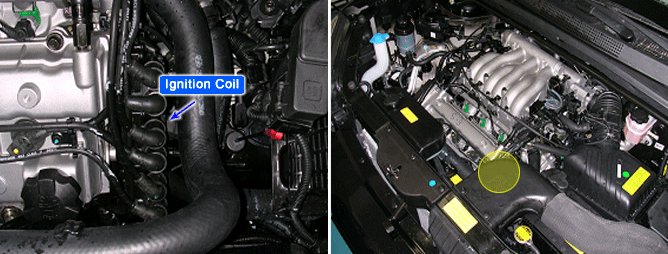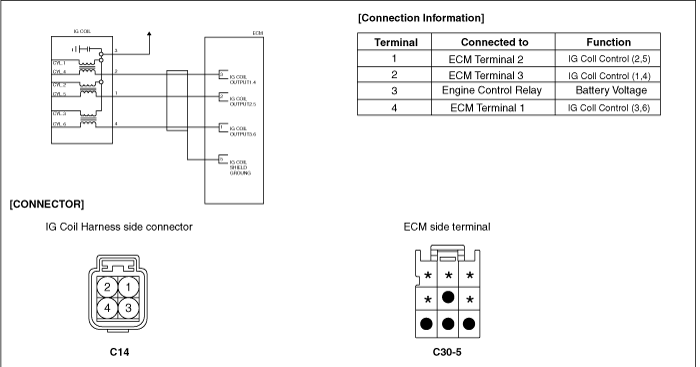Was a problem found in any of the above areas?

▶ Go to "Fuel System Inspection" procedure

▶ Repair air leakage and go to "Verification of Vehicle Repair" procedure.

The Misfire monitor diagnostic is based on crankshaft rotation velocity variation. The ECM determines crankshaft rotational velocity using the crankshaft position sensor and camshaft position sensor. When a cylinder misfires the crankshaft slows down momentarily. By monitoring the crankshaft and camshaft position sensor signals, the ECM can calculate when a misfire occurs. For a non-catalyst damaging misfire, the diagnostic will be required to report a misfire present within 1000-3200 engine revolutions. For catalyst damaging misfire, the diagnostic will respond to monitor 200 engine revolutions. Rough roads may cause false misfire detection. The rough road(acceleration)sensor consists of a piezoelectric vibration pick up which detects vertical acceleration of the vehicle. The sensor signal is used by the ECM to determine the degree of vertical movement of the car, for example, on a bumpy road. Since this may also cause uneven engine running, the ECM uses the signal to distinguish the phenomenon from actual misfiring.
The ECM must monitor the engine for misfiring possibly caused by ignition coil defects or injector fails. If misfiring is detected, the ECM will identify the cylinder(s) that has(have) misfired and then calculate misfiring rate for a given duration. The DTC for Misfire (P0301 to 0306) is set as soon as the misfiring rate exceeds the limit which may result in damage to the catalyst or increase emissions. The ECM stores the individual DTC for a cylinder which has more than a 10% total misfire rate. With a more than two cylinder misfire detection, the ECM sets P0300.
ITEM | DETECTING CONDITION | POSSIBLE CAUSE | |
DTC Strategy | ●Calculation of engine roughness | ●Faulty spark plugs, hightension lead, or Ignition coil ● Incorrect valve timing ● Uneven compression ● Air leakage ● Improper Fuel pressure or dirty fuel. ● Blocked/Leaking injectors ● Leakage between cooling system and cylinder | |
Enable Conditions | ●After starting ●Mass air flow 〉Approx. 0 ●550< Engine speed(RPM)〈 6500 ●Intake air mass gradient is in predetermined range ●Throttle Angle gradient is in predetermined range ●No injector shut off ●No rough road | ||
Case 1) | Threshold Value | ●Misfire= 6~17 %within 200 rev. | |
Diagnosis Time | ●200 revolution: 3*200 revolution | ||
Case2) | Threshold Value | ●First 1000 rev.: Misfire〉2% ●After first 1000 rev.: Misfire 〉2% | |
Diagnosis Time | ●1000 revolution: 4*1000 revolution | ||

Visually/physically inspect the air leakage in intake/exhaust system as following items,
If OK, go to next step
If NG, repair as necessary and go to "Verification of Vehicle Repair" procedure.
Vacuum hoses for splits, kinks and improper connections.
Throttle body gasket
Gasket between intake manifold and cylinder head
Seals between intake manifold and fuel injectors
Exhaust system between HO2S and Three way catalyst for air leakage
Was a problem found in any of the above areas?

▶ Go to "Fuel System Inspection" procedure

▶ Repair air leakage and go to "Verification of Vehicle Repair" procedure.
Check the fuel for excessive water, alcohol, or other contaminants. Replace contaminated fuel as necessary.
Install a fuel pressure gage.
Start engine and let it idle. Inspect fuel pressure with vacuum hose disconnected.
Test Condition : Engine "ON" at Idle
Specification : 330~350kPa(3.30~3.50 kg/㎠, 47~50 psi)
Is fuel pressure within the specification?

▶ Check for poor connection between ECM and component: backed out terminal, improper mating, broken locks or poor terminal to wire connection. Repair as necessary and go to "Verification of Vehicle Repair" procedure

▶ Repair as necessary refer to inspection noted as below and go to "Verification of Vehicle Repair" procedure
Check if fuel line pressure decreases when accelerating quickly.
- If it does, check fuel pump maximum pressure. If pressure is OK, check fuel line and filter for clogging. |
If fuel pressure is lower than specification : Check for fuel line pressure while pinching fuel return hose.
- If pressure quickly increases, check pressure regulator - If pressure gradually increases, check for clogging between fuel pump and pressure regulator. If hose is not clogged, check fuel pump maximum pressure. |
If fuel pressure is higher than specification : Is fuel line clogged?
- If it is not, replace pressure regulator. - If it is, replace it. |
After a repair, it is essential to verify that the fault has been corrected.
Connect scan tool and select "Diagnostic Trouble Codes(DTCs)" mode.
Press F4(DTAL) and confirm that "DTC Readiness Flag" indicates "Complete". If not, drive the vehicle within conditions noted in the freeze frame data or enable conditions.
Read "DTC Status" parameter.
Is parameter displayed "History(Not Present) fault"?

▶ System performing to specification at this time. Clear the DTC

▶ Go to the applicable troubleshooting procedure.